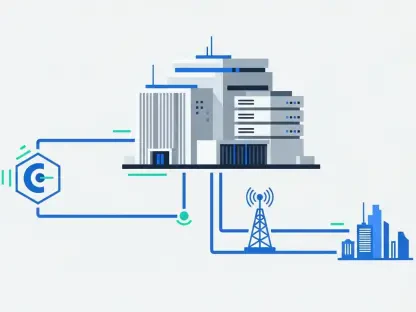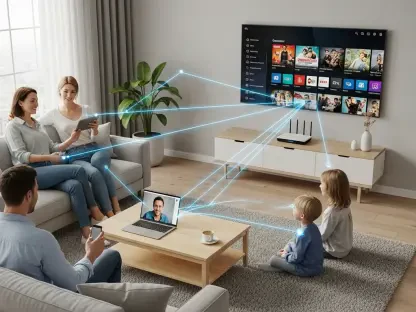In a groundbreaking move that could reshape Japan’s telecom landscape, Nvidia and SoftBank are poised to lead an AI and 5G transformation. This ambitious partnership marks a significant leap in technological advancement, integrating Nvidia’s latest Blackwell AI chips with SoftBank’s extensive telecom networks. Announced at the Nvidia AI Summit in Japan by Jensen Huang, Nvidia’s CEO, this collaboration aims to harness the power of AI and 5G to enhance both industries’ capabilities. SoftBank’s pioneering efforts to build Japan’s most powerful AI supercomputer, utilizing the Nvidia Grace Blackwell platform, exemplifies the depth of this alliance. This collaboration also extends to trials merging AI and 5G networks, with SoftBank leveraging Nvidia’s AI Aerial accelerated computing platform. This synergy, known as Artificial Intelligence Radio Access Network (AI-RAN), aims to revolutionize how telecom base stations operate, transforming them into versatile, revenue-generating assets capable of performing AI and 5G functions simultaneously. The implications of this partnership are vast, promising to elevate Japan’s role in the global technology arena and influence various sectors, including telecommunications, transportation, robotics, and healthcare.
The Birth of AI-RAN
The outdoor trials conducted by SoftBank in Kanagawa proved promising as AI-RAN technology provided carrier-grade 5G service seamlessly while managing AI inference workloads effectively. This development showcases the potential of AI-RAN in delivering dual functionalities efficiently, making it a viable option for telecom operators worldwide. According to projections by Nvidia and SoftBank, the revenue potential from this configuration is significant. Telecom operators could see an estimated $5 return in AI inference revenue for every $1 invested in AI-RAN infrastructure, indicating a substantial return on investment. SoftBank predicts a 219% return on investment per AI-RAN server, highlighting the economic efficiency of this cutting-edge technology. Such figures underscore the viability and promising future of integrating AI into telecom networks, offering a glimpse into how telecom operators can monetize AI services while providing high-quality 5G connectivity.
This initiative represents a pivotal step in what Nvidia’s Huang described as Japan’s AI industrial revolution. With considerable investments in Nvidia’s AI, Omniverse, and 5G AI-RAN platforms, Japan is positioning itself as a leader in global technological advancement. This transition is expected to have far-reaching impacts on various sectors, creating a ripple effect that could transform industries from telecommunications and transportation to robotics and healthcare. The successful AI-RAN trial epitomizes the integration of valuable AI applications such as autonomous vehicle support, robotics control, and edge-based multimodal retrieval into an AI-driven network. The potential for growth and innovation in these areas is immense, signaling a new era of technological transformation that positions AI as a core component of future telecom infrastructure.
Sustainability and Efficiency
A compelling aspect of SoftBank’s AI-RAN is its commitment to sustainability and efficiency. Nvidia’s Aerial RAN Computer-1 systems, which SoftBank will deploy, promise to be 40% more energy-efficient compared to standard 5G infrastructure. This represents a significant stride toward sustainable technology, reducing the overall carbon footprint of telecom networks. The emphasis on energy efficiency not only aligns with global trends towards greener technologies but also underscores the economic benefits of reduced operational expenses. The integration of serverless application programming interfaces and orchestrator from Nvidia AI Enterprise further enhances the system’s efficiency. These tools will enable SoftBank to distribute external AI tasks to AI-RAN servers swiftly, ensuring low-latency and secure AI services. This advanced distribution capability allows for more effective utilization of computing resources, maximizing output while minimizing energy consumption.
SoftBank’s deployment of its DGX SuperPOD, fortified with Nvidia’s AI Enterprise software and Quantum-2 InfiniBand networking, is set to establish Japan’s most powerful AI supercomputer. This advanced system, powered by Blackwell technology, will play a critical role in generative AI development and support various sectors, including academia and business. The significance of having such computing power lies in its ability to drive innovations that require immense processing capabilities, fostering advancements that can propel multiple fields forward. SoftBank’s plans to build an additional supercomputer dedicated to high-performance computing tasks, using the Nvidia Grace Blackwell platform, further exemplifies their commitment to pushing the boundaries of technological capability. These endeavors highlight the synergy between AI and 5G, showcasing the transformative potential when cutting-edge technologies are combined.
Fostering AI Innovation
In a pioneering move set to reshape Japan’s telecom landscape, Nvidia and SoftBank are spearheading an AI and 5G transformation. This ambitious partnership signifies a major leap in technology, combining Nvidia’s cutting-edge Blackwell AI chips with SoftBank’s vast telecom networks. Announced by Nvidia CEO Jensen Huang at the Nvidia AI Summit in Japan, this collaboration aims to leverage AI and 5G to boost capabilities across both industries. SoftBank is building Japan’s most powerful AI supercomputer using the Nvidia Grace Blackwell platform, highlighting the partnership’s profound depth. Additionally, the collaboration includes trials that merge AI and 5G networks, with SoftBank utilizing Nvidia’s AI Aerial accelerated computing platform. This synergy, termed Artificial Intelligence Radio Access Network (AI-RAN), aims to revolutionize telecom base stations, transforming them into versatile assets capable of performing both AI and 5G tasks. The partnership’s implications are significant, promising to boost Japan’s global technology presence and impact sectors such as telecommunications, transportation, robotics, and healthcare.









